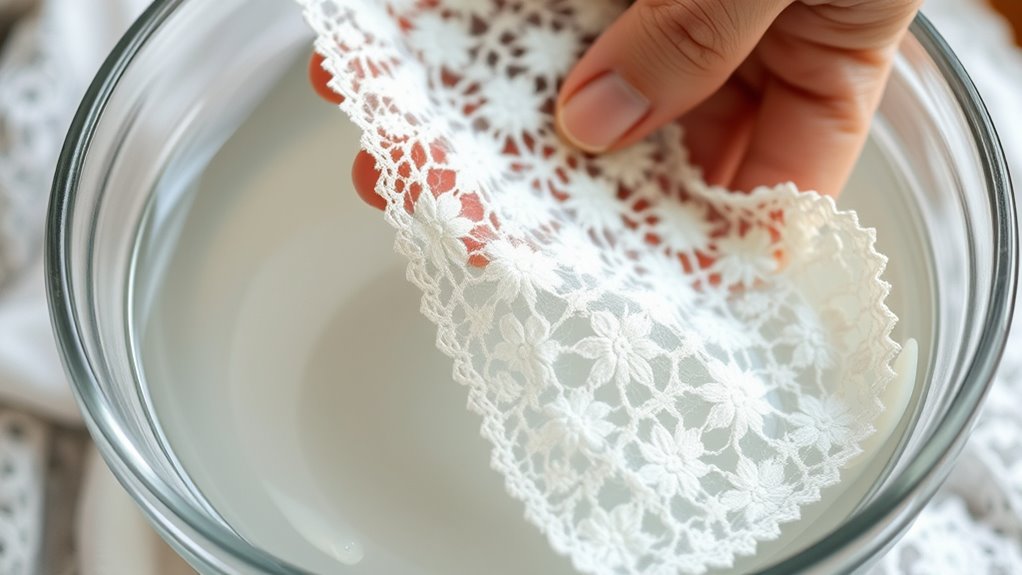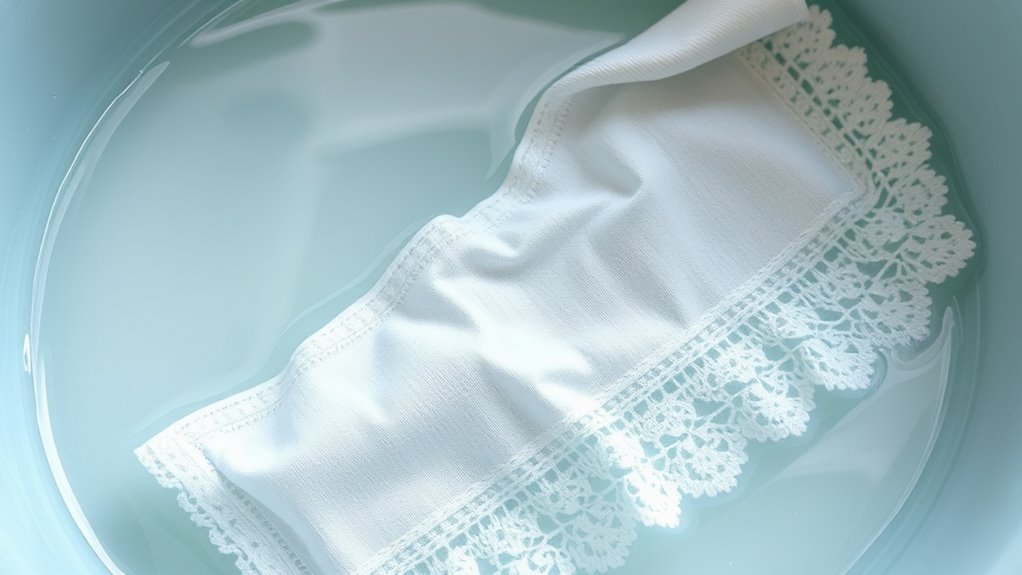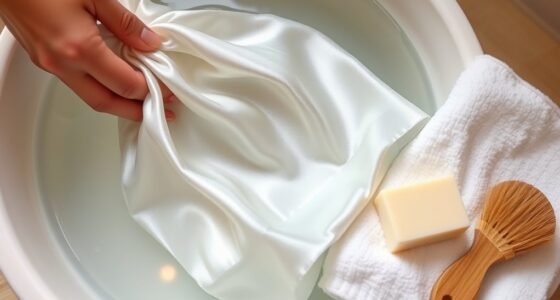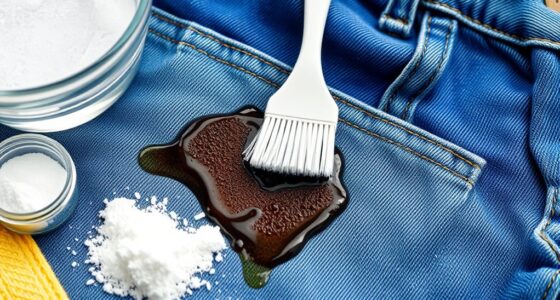To wash delicate lace and vintage linens, gently handle each piece to avoid damage, supporting them fully when lifting. Use lukewarm water with a pH-neutral detergent and avoid scrubbing or wringing. For softness, add a small amount of white vinegar during rinsing instead of commercial fabric softeners. Air dry by laying items flat on a towel or drying rack, away from sunlight. Proper storage and careful handling after washing will keep them beautiful; discover more tips for best results below.
Key Takeaways
- Use lukewarm water with pH-neutral detergent, avoiding vigorous scrubbing or twisting to prevent damage.
- Gently swish linens in water, then rinse thoroughly to remove soap residues and maintain softness.
- Avoid tumble drying; instead, gently press out excess water and air dry flat in a well-ventilated area away from sunlight.
- Handle delicate fabrics carefully when lifting or moving, supporting entire pieces to prevent stretching or tearing.
- Store linens folded in breathable containers like cotton bags or tissue paper to preserve texture and prevent dust buildup.

Delicate lace and vintage linens require gentle handling to preserve their intricate patterns and soft textures. When it comes to washing these fragile fabrics, your goal is to clean them thoroughly without causing damage. Fabric softeners can be tempting because they make linens feel plush and smooth, but for vintage and lace items, it’s best to avoid traditional fabric softeners altogether. These products often contain chemicals that can weaken fibers or leave residues that build up over time, dulling the fabric’s delicate appearance. Instead, opt for natural alternatives like white vinegar during the rinse cycle, which helps soften fabrics without harming their integrity.
Drying techniques are equally essential. You shouldn’t toss vintage linens or lace into a dryer, as the heat and tumbling can cause fibers to shrink, warp, or tear. The safest approach is to gently press out excess water without wringing, which can distort the fabric’s shape. Lay the linens flat on a clean, dry towel and roll it to absorb remaining moisture. Then, lay the item flat on a drying rack or another dry towel in a well-ventilated area, away from direct sunlight, which can fade colors or weaken fibers over time. Air drying not only preserves the fabric’s shape and softness but also prevents heat damage.
When washing, use lukewarm water, as hot water can weaken delicate fibers and cause shrinkage or discoloration. Fill a clean basin or sink with water and add a gentle, pH-neutral detergent specially formulated for delicate fabrics. Swish the linens gently to loosen dirt but avoid vigorous scrubbing or twisting, which can tear or fray the lace and vintage fibers. Rinse thoroughly to remove all soap residues, ensuring no residue remains that could cause stiffening or deterioration over time.
After washing, handle your vintage linens with care. Support the entire piece when lifting it from the water or drying area to prevent stretching or tearing. Never wring or twist the fabric; instead, gently press out excess water by pressing between clean towels. For storage, fold linens carefully and store them in a cool, dry place. Avoid plastic containers that can trap moisture, leading to mold or mildew. Instead, opt for breathable cotton storage bags or wrapped tissue paper to maintain their softness and prevent dust accumulation.
Frequently Asked Questions
Can I Use Bleach on Delicate Lace and Vintage Linens?
You shouldn’t use bleach on delicate lace and vintage linens because it can cause damage. Instead, opt for bleach alternatives like hydrogen peroxide or oxygen-based whiteners for stain removal techniques that are gentler. Always test a small, hidden area first to verify safety. These methods effectively lift stains while preserving the fabric’s integrity, helping your vintage linens stay beautiful and intact for years to come.
How Often Should I Wash Vintage Linens?
You should wash vintage linens only when they need it—no more, no less. Overwashing risks fabric preservation, turning delicate fibers into historical dust. Spot stain removal works wonders, so you don’t have to wash after every glance. Think of your linens as ancient art: too frequent cleaning erodes their charm. When in doubt, inspect for stains or odors, then gently refresh to keep their story alive.
What Are the Signs My Linen Is Damaged?
You’ll notice your linen shows signs of damage if the fabric looks frayed, threadbare, or has holes. Discoloration or persistent stains that resist removal suggest fabric preservation issues. Feel for stiffness or rough patches, which can indicate weakening fibers. If the linen feels fragile or tears easily, it’s a sign it’s been compromised. Regular gentle stain removal and proper cleaning help maintain its integrity and prolong its lifespan.
Is Dry Cleaning Safe for All Vintage Linens?
Is dry cleaning always the safest choice for vintage linens? Not necessarily. While dry cleaning can be gentle and effective, it’s essential to contemplate fabric safety, as some delicate lace or antique textiles may be damaged by harsh chemicals or improper methods. Always check labels and consult a professional cleaner experienced with vintage fabrics. When in doubt, hand washing with gentle solutions might preserve your linens longer and prevent irreversible damage.
Can I Machine Wash Delicate Lace Without Special Settings?
Yes, you can machine wash delicate lace without special settings, but you should use a gentle cycle to prevent damage. Place the lace in a mesh laundry bag for extra protection and avoid fabric softeners, as they can weaken delicate fibers. Use cold water to minimize shrinking or stretching, and skip the dryer. Instead, lay the lace flat to air dry for best results.
Conclusion
Caring for delicate lace and vintage linens keeps these treasures beautiful for years. Remember, over 60% of antique textiles are damaged by improper washing, so gentle handling is essential. Use mild detergents, avoid wringing, and air dry whenever possible. By following these simple tips, you’ll preserve their intricate details and timeless charm, ensuring they remain cherished heirlooms. With just a bit of care, your vintage linens can continue to tell their story for generations to come.









